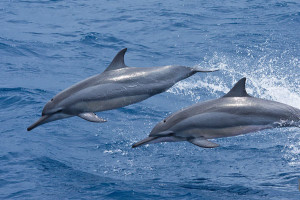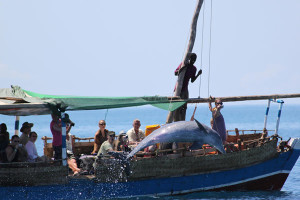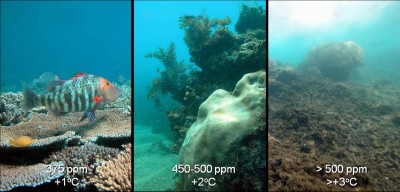By PATRICK MAYOYO editor@africaeconews.com
Dolphins world over are under threat from effects of climate change, and the Kenyan coast is no exception.
The studies show that among the impacts of climate change are increases in sea surface temperature and the sea level, decreases in sea ice cover and changes in salinity, alkalinity, wave climate, ocean circulation, and primary productivity.

Dolphins enjoying themselves in their habitat. PHOTO: Watamu Marine Association.
According to, Mr Randall S. Wells of the Chicago Zoological Society, the concept of global climate change means that there will be ramifications for life throughout the world from changes associated with global warming.
“Exactly when these environmental changes may become detectable in different habitats outside of polar regions, how severe they will become, and how the marine mammals will respond to them is unknown,” Mr Wells says.
One of the better-known non-polar cetacean species, distributed widely through temperate-tropical coastal waters, is the common bottlenose dolphin (tursiops truncates).
Three options
It is among dolphins found along the Kenyan coast. Others are the Indo-Pacific humpback, stripped and spinner dolphins.
Mr Wells, who is also the president of the Society for Marine Mammalogy, says that bottlenose dolphins impacted by climate change face three basic options for responses.
“They may be able to redistribute as conditions change, meaning that they can follow or avoid changes to remain within an acceptable range of temperatures or other environmental parameters,” he notes.
Writing for ‘The Whalewatcher,’ a journal of the American Cetacean Society, Mr Wells adds that alternatively, the dolphins may remain within their historical ranges and adapt to the changing conditions, within the physiological, ecological, and behavioral limitations of the species or population.
The third option is to go extinct.
Other studies show that dolphins along the Kenyan coast and in Africa in general are under threat from unsustainable fishing, expanding tourism and habitat destruction.
According to the Worldwide Fund for Nature (WWF), other threats to dolphins in Kenya and Africa include illegal killing and the growing risks of offshore oil and gas exploration.
The waters off Kenya’s north and south coast harbour several species of small cetaceans, among them dolphins.
Dolphins are cetacean mammals closely related to whales and porpoises. There are almost 40 species of dolphin in 17 genera. They vary in size from 1.2 metres up to 9.5 metres (30 ft) and 10 tonnes for the orca, or the killer whale.
Dolphins are found worldwide, mostly in the shallower seas of the continental shelves and are carnivores, eating mostly fish and squid.
According to, Mr Steve Trott, the projects development manager of Watamu Marine Association, the major threats facing dolphins along the Kenyan coast are human related.
“Death by drowning is one of the main problems as all marine mammals are susceptible to being caught in fishing nets, accidentally or deliberately as bycatch,” he says.
He adds that abandoned nets classified as marine debris also trap dolphins and whales. “Similarly, marine rubbish (especially plastics) can cause death if ingested by marine mammals.”
Use of air guns
Mr Trott says oil and gas exploration can cause damage to dolphin and whale hearing, especially the use of air guns during seismic surveys.
“Dolphins become so disorientated that they beach themselves on land,” he says.
Currently, Camac Energy Ltd based in the USA has leased oil and gas block L 16 which includes the Malindi-Watamu National Marine Parks and Reserves and they plan such surveys at a time yet to be disclosed.
“This development is of great concern to not only conservationists but also local boat operators and safari sellers who rely on dolphin and whale watching for an income,” he said.

Tourists and tour guides prepare for an expedition to view dolphins in Watamu marine park and reserve.
Mr Trott says research organisations, conservation groups, and government agencies have formed a national coalition called the Kenya Marine Mammal Network (KMMN) to protect dolphins.
“This was formed by Global Vision International – Shimoni Kenya, and Watamu Marine Association. Partners include Kenya Wildlife Service, Kenya Marine and Fisheries Research Institute, NEMA, WWF Kiunga and Kenya Sea Anglers Association (KASA), with the purpose to discover more about dolphins, whales and dugongs in Kenya,” he adds.
Mr Trott says the Kenya Marine and Fisheries Research Institute has launched a project to research on the number of dolphins being illegally killed for meat or those that die due to unsustainable fishing practices.
“The ‘BYCAM’ research project supported by West Indian Ocean (WIO) is researching the effects of bycatch in Kenya, Zanzibar, Tanzania, Mozambique and Madagascar,” he says.
He says going into 2017, this will be the first study of its kind and is expected to provide essential information for reducing dolphin and whale bycatch.
“It has been established that the Indo-Pacific humpback dolphin numbers have declined seriously through bycatch and they are classed as near threatened by the International Union for Conservation of Nature (IUCN) Red List,” he said.
Increase awareness
He says little is known about dolphins along the Kenyan coast and the aim of the ongoing research was not only to collect more information about numbers and hot spots along the coast, but also to increase awareness.
According to WWF, dolphins along the West Africa coast are also under threat.
The waters off West Africa are home to several dolphin species, including the endemic Atlantic humpback and a largely isolated population of long-beaked common dolphins.
WWF says these dolphins, however, are facing increasing pressure from unsustainable fisheries, habitat destruction, illegal killing, expanding tourism, and the growing risks of offshore oil and gas exploration.
WWF is working with West African countries to promote effective conservation measures to protect the endangered dolphin species.
This includes a comprehensive assessment report on the status, distribution, key habitats and threats facing the dolphins, which will contribute to coordinating local and regional action plans.
Studies show that average global land and sea temperatures have risen about 1.4 degrees Fahrenheit since record keeping began in 1880 and continue to rise.

A dolphin jumps near a tourists’ boat during a tour at Watamu marine park and reserve. PHOTO: Watamu Marine Association.
Globally, 2014 was the hottest year on record. And the 16 hottest years ever recorded have all occurred since 1997.
Most scientists believe global sea level will rise by as much as another two feet by the end of this century, and very possibly more.
The executive director of American Cetacean Society, Dr Cheryl McCormick, says climate change is one of the most significant yet least understood threats to cetaceans today.
Dr McCormick says scientists do not dispute the fact that climate change is happening, and at a pace beyond some species’ ability to evolve and adapt.
“Some of our most iconic species in the Arctic and Antarctic regions of the world, such as the beluga, narwhale, bowhead, and Antarctic minke whales, are among the most vulnerable, in part due to changes in sea ice cover,” the director adds.
Adapt and evolve
Dr McCormick notes that less ice makes it more difficult for cetaceans to locate prey, allows access by humans to previously inaccessible habitats, increases interactions among competitors, predators, and disease vectors, and exposes highly social and vulnerable species to human activity, such as ship strikes, entanglement in fishing gear, and hunting.
Mobile cetacean species whose habitat needs are more generalist in nature will likely have a greater ability to adapt and evolve to ever-changing climate conditions than their brethren living in polar regions.
Mr Trott said so far Kenya’s success in the conservation of dolphins is the establishment of the KMMN and increased awareness of dolphins and whales along the Kenyan coast.
“It is clear that Kenya needs to develop a National Marine Mammal Conservation Strategy and, with increased collaboration and extension of the KMMN, this is achievable,” he said.
Source: Africa Eco News







 … They Keep Breaking Scientists’ Charts
… They Keep Breaking Scientists’ Charts

